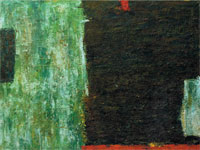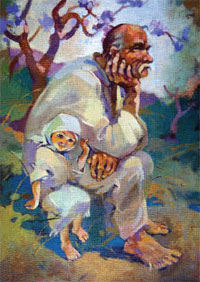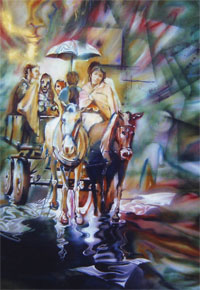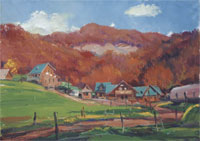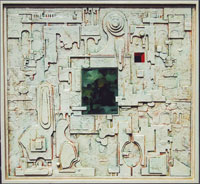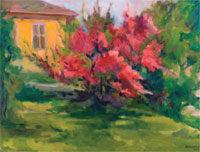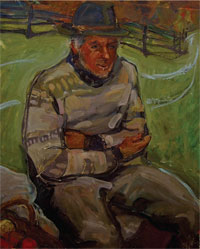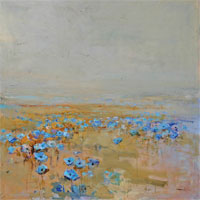 |
Taras Tabaka: Whatever they say, to my mind, the whole-hearted creator has to be interested first of all that his own thoughts, feelings and actions are irreproachable. |
There is nothing worse for the work of art than absence of words. Every artistic intention realised on canvas is the manifestation of the soul, of the heart and reason of the artist. The variety of trends, genres, techniques and definitions are the moment of escape from the delusiveness of the modern world, the moment of the immersion into the dialogue with a spectator.
Nowadays the scale of the development of the Transcarpathian painting is rather wide both in concept and style. The general picture includes the canvases that seem to appear at different poles of creative mind: from purely realistic approach to abstract visions. This is the range of the modern exposition of the Transcarpathian painting.
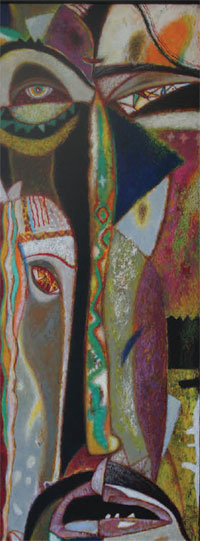 |
| Ihor Paneyko: The life is wonderful, striking and amazing. |
Interpenetrating of prehistoric, pagan, Christian cult layers in a single space and time dimension or rather regardless of time and space – this is the basis of the creative work of Ihor Paneyko. There the time is only expectation, there everything has been and everything is present. The artist manages to plunge into the timeless depth, creating the myths of his own. He brings in the feelings and revelations, where the image-symbol is dominating and not the sober memory of a connoisseur.
Tiberiy Silvashi was formed as an artist in 1960–1970, in the exciting and revolutionary time of the "men of 1960s" who would be later called the "painters of underground". Probably the essence of his "revolution" was not the novelty of painting, but assertion of his spiritual space, authenticity of his art. Without a hint of concrete interest to objects, maestro paints now his symphony of pure painting, where every part is a detonation of colour, a self-creative element in universal law of gravity.
The canvases of Taras Tabaka and Volodymyr Bazan enchant you by the effect of dream visions. It seems that creative process of the artists has turned into the time of fancy, where the timeless is the main component. The state of soul bareness, super sensitiveness calls for the visions of the past, present and future as a single whole, inhabited by images. Large canvases of Taras Tabaka impell the spectator to plunge into the splendid painting, one gets absorbed by its effect. Meetings, partings or silent monologue on the canvases of Volodymyr Bazan appear as combination of real and imaginary, where every detail is not passive and fragments make the atmosphere.
 |
Stepan Sholtes: Carpathian mountains are special mountains of the special land. They protect us, make the environment of the bright life, filled with colours of joy and shades of generous sun. |
 |
Oleksandr Sydoruk: The gift of creating – it is a mode and forms of thinking, it is a possibility to speak of the things, that need no words, that speak for themselves. |
 |
Stepan Mostrianskiy: Creative work is like sails of freedom. |
 |
Volodymyr Bazan: I know that painting for me is like breathing. If I don't create, I don't live. |
 |
Arthur Brahinskiy: I think that the painting of the future will be first of all treated in the aspect of balance and harmony. |
The creative work of Oleksandr Sydoruk is distinguished by the non-ordinary combination of colours and his ability to gain the tense and energetic rhythm. To overcome the consumer attitude to the tradition – is the creative credo of the artist.
The search of character, emotional decorative expressiveness reflect the strength of emotions of Oleksandr Osypchuk, Ihor Lutsenko and Viktor Myhovych. Still-lives or landscapes, genre or abstract paintings, they render a certain psychological state, a mood, where the form and the lyrics are combined, and a passion for beauty sounds equally strongly both in a small still-life and in the landscape with Carpathians panorama.
Love for landscape is quite natural for the artists who love their land – native and close to their hearts. Stepan Sholtes, Vasyl Brenzovych, Vasyl Popovych create the images of surrounding space penetrating with all their souls into the depth of things and transforming them in a philosophical way. They stress the main and the eternal, the ordinary and the festive, everything caught by sight and feelings. The works of the painters attract by the palette of colours and their complex combinations.
The classical school of painting makes the basis of the creative work of Arthur Brahinskiy, Yuriy Kopanskiy and Heorhiy Levadskiy. The zest of the genre painting of Heorhiy Levadskiy is the ability to render the colour reflexes, the complex under-tints that provoke the feeling of the time rhythm of the small town.
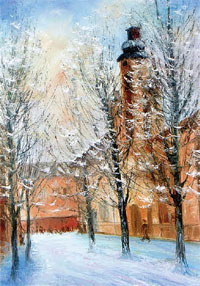 |
The works of Yuriy Kopanskiy are outwardly realistic and impressionistic: thorough drawing, precision of details, the general colour mood that doesn't contradict the real colours and exclude such notions as flabbiness and boredom.
Atur Brahinskiy is the artist of active perception. He does not simply describe the nature, he tries to understand it. That is why his lyrical landscapes are very dynamic in essence. Both colour correlation and rhythms tensity contribute to this. In his works one can feel a kind of reticence, mystery and this makes them still more attractive.
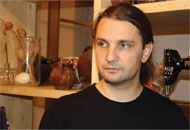 |
Yuriy Kopanskiy: Nobody can explain the wish to paint. Eyes see, hands paint, no matter how banal it sounds. |
 |
E. Hurevych: It is characteristic for my creative work to aspire to philosophically understand the life, frankness to yourself and to people. |
 |
O. Osypchuk: Artist is not he who can paint, but he who cannot not to paint. |
 |
Vasyl Brenzovych: Creation must be present in all the things of the artist's life. |
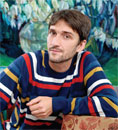 |
Viktor Myhovych: When a work of art is being born, you seem to stand at the wheel of a ship, whose name is "Expressive experiment" and which sails in a stormy sea of energy and fantasy. |
 |
Ivan Masniuk: To create means to feel the necessity to speak to people in the voice of your soul. |
Estimating the present situation in the development of the Transcarpathian pictorial art, one should mark an inconceivable expansion of the artistic search and experiments, further deepening of the art synthesis.
The artistic thought and the fleeting processes of the present are merging – this is the tendency that has been gradually outlined. The Transcarpathian school experiences the period of combining the retrospective feature, marked by certain nostalgia, with original interpretation and modern art language and with unexpected manifestation of the Ukrainian mentality.
Oksana Havrosh,
Uzhhorod







